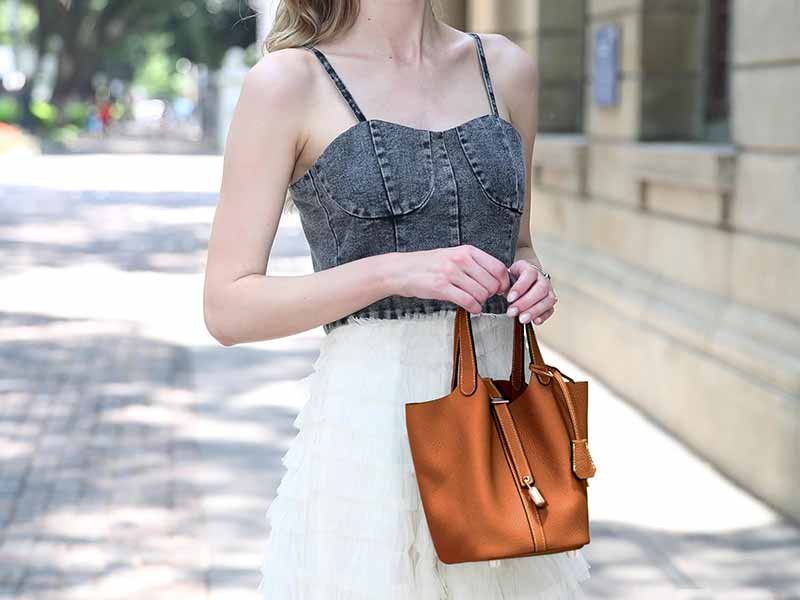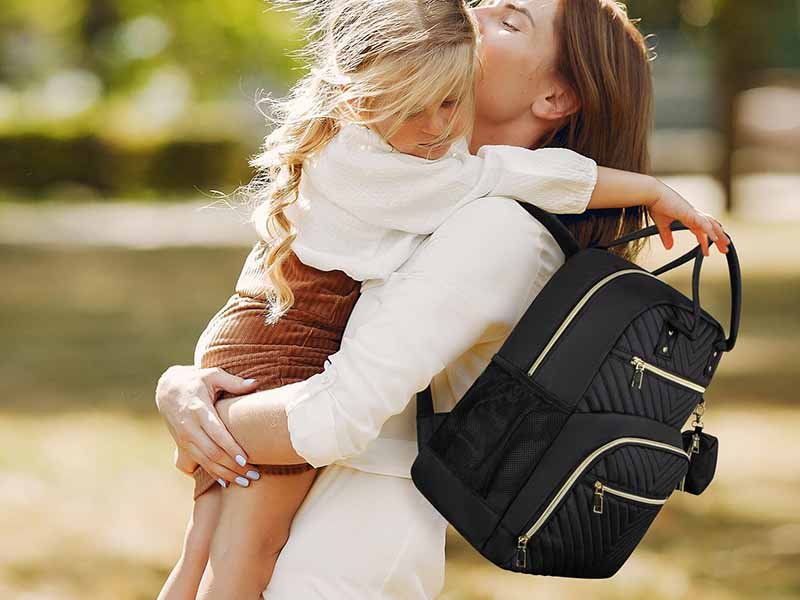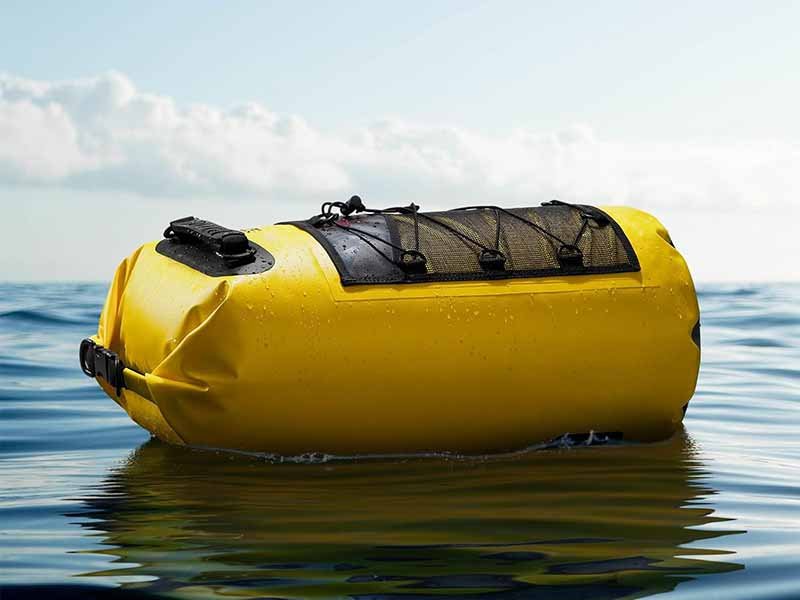A briefcase is more than just a bag—it’s an essential business accessory that can elevate your professionalism and keep you organized. Whether you’re in corporate, legal, or any other profession that requires carrying documents, laptops, or personal items, choosing the right briefcase is crucial for both function and style.
A briefcase is a structured bag designed to carry business essentials, like documents and electronics, in an organized and professional way. From classic leather to tech‑specific briefcases, the right briefcase reflects your personal and professional style while offering superior functionality.
Briefcases have come a long way from their early designs, evolving with changing work styles. But one thing remains constant: the need for a functional, stylish way to carry your essentials. Let’s dive into the different types, materials, and features that make a briefcase a must‑have for professionals.
What is a Briefcase?
A briefcase is a structured, rectangular bag—traditionally with a hinged top and single handle—designed to carry documents, laptops, tablets, and other work essentials in an organized, professional manner. Think of it as the modern evolution of the old-style “attaché case,” but built for today’s mobile worker.
History of Briefcase
The briefcase’s story begins in the 14th century when scholars and clerks carried parchment rolls in leather pouches. By the 19th century, as legal and commercial work grew, paper documents needed flatter, more protective cases:
- Early Attaché Cases (1850s–1900s)
- Design: Flat, box-like wooden frames covered in leather, hinged at the top.
- Use: Diplomats (“attachés”) and legal clerks used them to transport sensitive papers securely.
- Classic Leather Briefcase (1920s–1950s)
- Evolution: Steel-reinforced frames and spring-loaded clasps replaced wood, creating the iconic rigid “doctor’s-bag” shape adapted for documents.
- Material: Full-grain cowhide became the gold standard—durable, professional, and able to develop a rich patina over time.
- Soft-Sided and Fabric Briefcases (1960s–1980s)
- Innovation: As business travel increased, lightweight nylon and canvas models emerged. These offered zippered closures and shoulder straps for comfort.
- Impact: Professionals gained more flexibility in carrying both documents and early laptops.
- Tech-Centric Designs (1990s–2000s)
- Shift: The laptop era drove the addition of padded compartments, cable ports, and quick-access pockets.
- Material Blend: Combinations of leather, ballistic nylon, and metal hardware balanced protection with style.
- Modern Hybrid and Smart Briefcases (2010s–Today)
- Features: Built-in USB charging, RFID-blocking pockets, and even solar-powered panels for on-the-go power.
- Sustainability: Eco-tanned leathers and recycled fabrics reflect growing environmental awareness.
Core Characteristics:
- Structured Shape: Keeps papers and electronics from bending or getting crushed.
- Top Handle (and Often Strap): Easy to grab in one hand, with many designs offering an optional shoulder strap for hands-free carry.
- Dedicated Compartments: Padded laptop/tablet sleeves, zippered pockets for cables and chargers, slip pockets for business cards, pens, and a smartphone.
- Material Variations: From classic full-grain leather (for a timeless, high-end look) to lightweight nylon or hard-shell polycarbonate (for extra protection).
- Secure Closures: Zip tops, combination locks, or clasp hardware keep contents safe.
Who Uses a Briefcase?
- Executives and managers who need to transport contracts and presentations
- Lawyers and consultants juggling case files and laptops
- Salespeople carrying product catalogs and samples
- Anyone who values a polished, put-together appearance
What Are the Different Types of Briefcases?
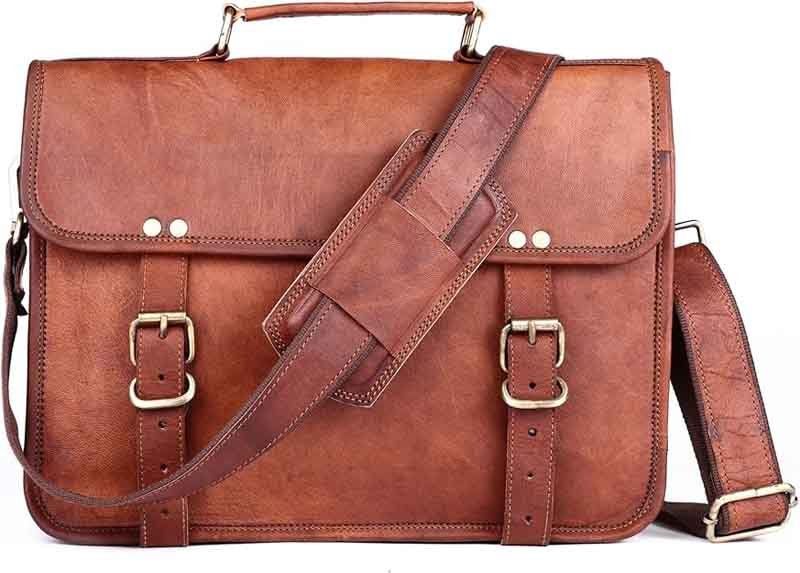
There are various types of briefcases available in the market, each catering to different needs. From sleek leather designs to durable tech‑specific cases, each type of briefcase offers unique advantages.
Briefcases come in several forms: leather, hard-shell, soft‑sided, and tech‑specific cases. Each type is tailored to meet specific functional needs, whether it’s protection for electronics or a sleek, professional appearance.
Exploring the Types of Briefcases
- Leather Briefcases Leather briefcases are often the go‑to choice for professionals seeking a balance between style and durability. Full‑grain leather offers the highest quality, developing a beautiful patina over time, while top‑grain leather provides a smooth, uniform look.
- Hard-Shell Briefcases Made from materials like plastic, aluminum, or carbon fiber, hard-shell briefcases are designed to offer maximum protection. They are ideal for carrying sensitive equipment like laptops, documents, or delicate electronics.
- Soft-Sided Briefcases Soft‑sided briefcases are more flexible than hard-shell designs. They typically offer more internal compartments and are made from leather, fabric, or canvas. These are great for professionals who carry multiple items and prefer a lighter load.
- Tech-Specific Briefcases These are designed to carry and protect electronic devices like laptops, tablets, and smartphones. Tech briefcases often feature padded compartments and organization for charging cables, ensuring the safe transport of sensitive equipment.
Which Materials Are Used for Making Briefcases?
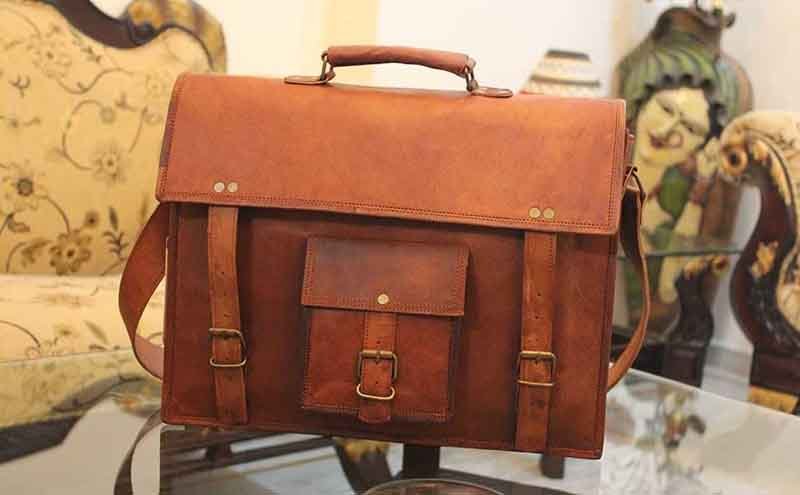
The material used in a briefcase affects its durability, appearance, and overall performance. Choosing the right material is critical based on how much use the briefcase will get and what it will carry.
Common materials for briefcases include leather, nylon, polyester, and synthetic blends. Leather offers a luxurious look with long‑lasting durability, while nylon and polyester are lightweight and water‑resistant, ideal for tech‑specific briefcases.
Material Options
| Material | Characteristics | Pros | Cons |
|---|---|---|---|
| Full-Grain Leather | The top layer of hide, with all natural markings intact | Extremely durable; develops rich patina | Heaviest and most expensive |
| Top-Grain Leather | Sanded to remove blemishes, then coated for uniformity | Smooth finish; lighter and less costly | Slightly less breathable; fewer natural markings |
| Pebbled/Corrected Grain | Embossed grain layer hides imperfections | Scratch-resistant; consistent look | Limited patina; feels “stamped” |
| Nylon (Ballistic/1680D) | High-strength synthetic fabric | Lightweight; water-resistant; affordable | Less “luxury” feel; can snag |
| Polyester | Budget-friendly woven fabric | Easy to clean; lightweight | Lower abrasion resistance; fades over time |
| Canvas (Cotton/Poly Blend) | Natural-looking woven fabric, often wax-treated | Casual look; good abrasion resistance | Heavier when wet; less formal |
| Synthetic Leather (PU/Vegan) | Man-made leather alternative | Cruelty-free; cost-effective | Peels/cracks sooner; minimal patina |
| Hard Shell (Polycarbonate/Aluminum/Carbon Fiber) | Rigid outer case | Maximum protection for contents | Bulky; higher price; less flexible |
- Leather (full-grain or top-grain) is the gold standard for a premium, long-lasting briefcase that ages beautifully.
- Nylon/polyester options are ideal for lightweight, water-resistant bags at lower price points.
- Canvas straddles the line between casual and durable, often used in hybrid designs.
- Hard-shell cases are purpose-built for maximum protection of electronics and documents.
How to Choose the Right Briefcase for Your Business Needs?
Choosing the right briefcase isn’t just about style—it’s about selecting a bag that meets your daily needs, whether that’s protecting your laptop or offering ample storage space for documents and personal items.
The right briefcase depends on your specific business needs. Consider factors such as size, weight, material, and functionality. If you travel frequently, a lightweight, durable bag with multiple compartments will be ideal. If you need to impress clients, a luxury leather briefcase may be more appropriate.
What to Consider When Selecting Your Briefcase
Capacity & Dimensions
- Laptop Sleeve Size: Measure your device—13″, 15″, or 17″—and add 1 cm for padding.
- Document Compartments: If you tote A4 or letter-size files, ensure an interior pocket at least 23 × 31 cm.
- Expandable Gussets: A 2–4 cm expandable gusset allows for fluctuate load—useful when carrying extra folders or a lunchbox.
| Feature | Minimum Dimension | Notes |
|---|---|---|
| Laptop Sleeve | 38 × 26 cm | Fits up to 15″ laptops |
| Document Pocket | 31 × 23 cm | Accommodates A4/letter documents |
| Expandable Gusset | +2–4 cm width | Ideal for occasional bulkier loads |
Material & Durability
- Leather vs. Nylon/Canvas: Leather (4–6 oz) offers a premium look and ages with patina, while nylon (420D) or waxed canvas (350 gsm) gives lightweight, water-resistant performance.
- Wear Points: Check handle bases and strap anchors—look for bar-tacks or rivets rated to at least 50 kg pull strength.
Organization & Accessibility
- Pocket Layout: A minimum of three internal pockets (laptop sleeve, zip pocket, slip pocket) plus two external quick-access pockets speeds retrieval of phone, keys, and cards.
- Tech Features: Built-in USB port, RFID-blocked pocket, and cable channels can add 10–15% to your convenience without bulk.
Carrying Style & Comfort
- Handles vs. Straps: A padded top handle eases hand-carry; a detachable, adjustable shoulder strap distributes weight—ideal if you’re on your feet between meetings.
- Ergonomics: Look for 40 mm-wide straps with high-density foam padding to reduce shoulder fatigue by up to 20% in long commutes.
Security & Professionalism
- Closure Types: Zippers offer full closure but may catch; latch-style or combination locks boost security by 30%, useful for travel.
- Aesthetic Consistency: Match hardware finish—brushed brass, matte black, or polished chrome—to your core wardrobe for a cohesive, professional look.
Budget & ROI
- Price Tiers: Tier Price Range (USD) Lifespan Estimate Cost/Year Mid-Range 100–200 3–5 years 20–67 Premium 250–500 7–10 years 25–71
- Investing in a higher-end briefcase often lowers cost per year over its lifespan while reinforcing your professional image.
How Do You Maintain and Care for a Leather Briefcase?
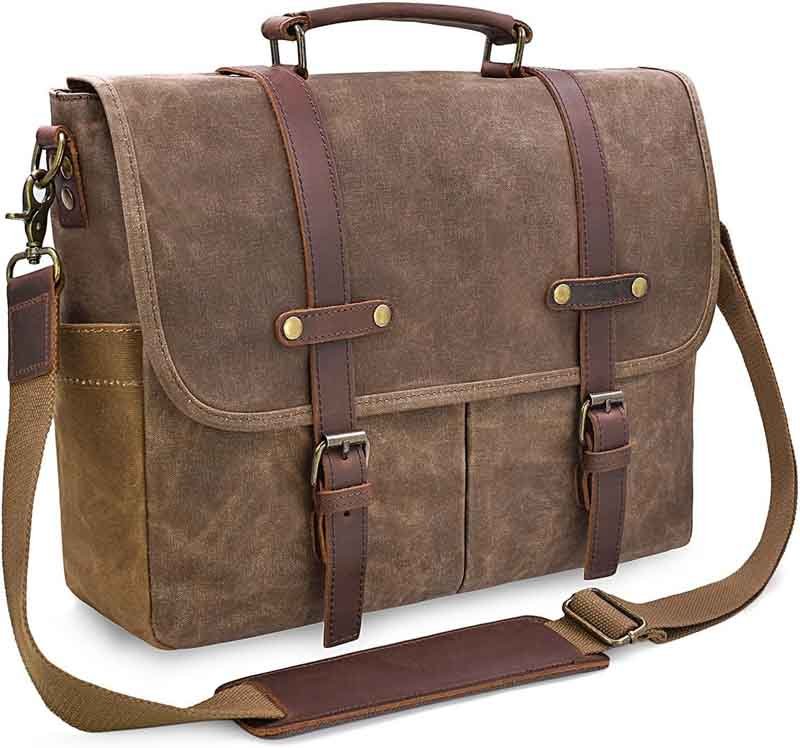
Leather is a durable, luxurious material, but it requires care and attention to keep it looking its best. With the right maintenance routine, your leather briefcase can last for decades while developing a beautiful patina. Proper care prevents cracking, fading, and wear over time.
To keep a leather briefcase in top condition, clean it regularly with a damp cloth, condition the leather every 3–6 months, and store it in a cool, dry place. Use leather polish to restore shine and prevent cracks.
1. Regular Cleaning
- Wipe Away Dirt and Dust: Use a soft, damp cloth to wipe away dust and dirt regularly. It’s best to clean your leather briefcase as soon as it gets dirty to prevent dirt from settling into the leather fibers.
- Avoid Harsh Chemicals: Never use household cleaners, soap, or alcohol-based solutions, as they can damage the leather’s finish. Instead, opt for a leather-specific cleaner or mild soap diluted with water.
Tip: Clean your briefcase every 2-4 weeks depending on use. For daily commuters, wiping down after each use will maintain the leather’s appearance.
2. Conditioning Leather
- Restore Moisture: Leather can dry out and lose its natural oils over time. Conditioning helps maintain the leather’s flexibility, preventing it from cracking or becoming brittle. Use a good leather conditioner or balm that is free from waxes and silicones.
- Apply Conditioners Sparingly: Too much conditioner can make the leather feel greasy or attract dirt. Apply a small amount with a clean cloth and rub it gently in circular motions.
Tip: Condition your leather every 3-6 months, or more frequently if the briefcase is used heavily. For older leather, conditioning can also restore lost moisture and flexibility.
3. Storing Your Briefcase Properly
- Store in a Dust Bag: When not in use, store your leather briefcase in a dust bag to prevent dust accumulation and exposure to light. The dust bag will also protect the leather from scratches and potential staining.
- Keep It Upright: Store your briefcase in a cool, dry place, and avoid cramming it into tight spots. Leather can deform if left in an overly cramped area, which may compromise the bag’s shape.
- Avoid Direct Sunlight: Leather should never be left in direct sunlight for long periods, as UV rays can cause it to dry out and fade. Store your briefcase away from windows or heat sources to maintain its color and suppleness.
Tip: If your briefcase is wet from rain or spills, never leave it in direct sunlight to dry. Instead, allow it to air dry in a shaded area and then apply a conditioner to prevent it from becoming too stiff.
4. Dealing with Stains and Scratches
- Tackle Spills Immediately: If your leather briefcase is exposed to spills like coffee or water, blot the liquid with a clean cloth immediately—never rub, as this can spread the stain. Wipe the area with a damp cloth and let it dry naturally.
- Buff Out Scratches: Small scratches can often be buffed out with a soft cloth or leather conditioner. For deeper scratches, you might want to consult a professional leather repair service.
- Use a Leather Protector: Leather protectors or sprays can create an invisible shield that helps repel water and stains. Be sure to test any product on a small, inconspicuous area of your briefcase before applying it to the entire surface.
Tip: Keep a leather repair kit with you, including a small cloth and conditioner, to address minor scuffs and spills when they occur.
5. Preventing Damage from Water
- Waterproofing: While leather has some natural water resistance, it’s important to protect it from heavy exposure to water. Consider using a leather waterproofing spray, especially if your briefcase will be exposed to rainy conditions.
- Drying Wet Leather: If your leather gets soaked, gently blot the water with a soft cloth, and allow the leather to air dry naturally. Never use a hairdryer or direct heat source to dry leather, as this can cause it to crack.
Tip: Use a leather-specific waterproofing treatment every 6 months, especially if your briefcase is regularly exposed to the elements.
6. Edge Finishing and Protection
- Protecting Edges: Leather edges are prone to wear and tear, so it’s important to regularly apply edge paint or wax to keep them smooth and intact. This also prevents fraying and adds a polished look.
- Regular Inspections: Examine the stitching and hardware on your briefcase regularly to ensure they remain intact. Loose threads or weak stitching can be repaired early to avoid further damage.
Tip: Apply a small amount of beeswax or edge sealant on the edges to protect them from water and abrasion. This is especially important if your briefcase is used frequently.
What Are the Advantages of Customizing Briefcases for Corporate Branding?
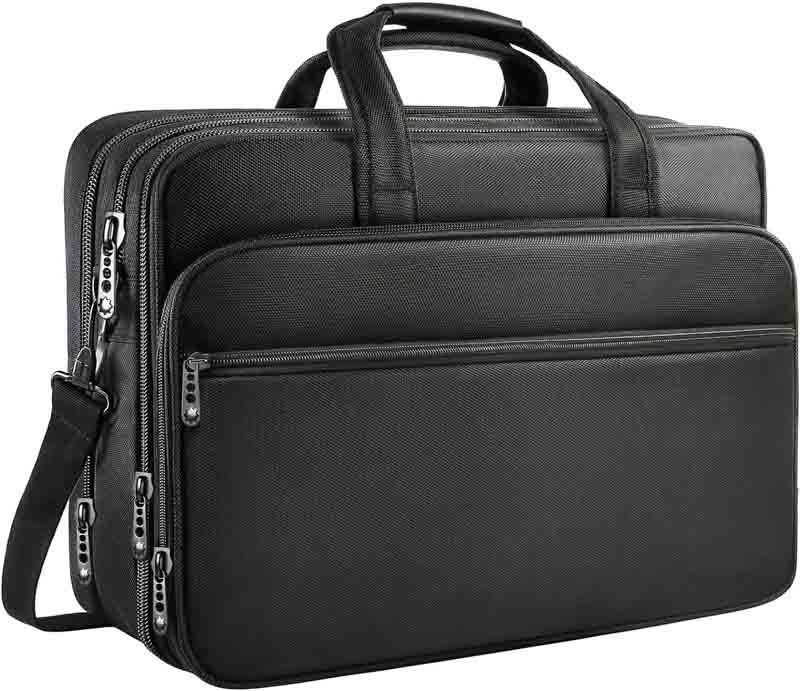
Customizing briefcases with your logo or design not only enhances your brand’s visibility but also makes a functional, high‑end gift that your clients and employees will appreciate.
Customized briefcases featuring your logo or unique design elements help increase brand recognition and customer loyalty. A branded briefcase can also serve as a memorable corporate gift, strengthening relationships with employees and clients.
1. Strengthening Brand Identity
- Logo Placement: Debossing or embossing your company logo on a briefcase adds a professional touch and reinforces your brand identity. The briefcase acts as a moving billboard, showcasing your brand in every business meeting or travel scenario.
- Unique Design Elements: Custom linings, color schemes, or accents aligned with your company’s branding palette make the briefcase more personalized and elevate your brand’s luxury perception.
2. Promoting Employee Loyalty and Engagement
- Corporate Gifts: Custom briefcases make exceptional corporate gifts. Employees and executives appreciate high‑quality, branded accessories that reflect their status within the company. Giving personalized briefcases shows that you value your team and enhances their work experience.
- Team Unity: Branded briefcases can symbolize a unified team, especially for corporate events, conferences, or seminars, helping build a sense of pride among employees.
3. Effective Marketing Tool
- Walking Advertisement: Every time a client or employee carries a branded briefcase, they effectively market your company to potential customers and business partners. The briefcase acts as an ambassador, showcasing your professionalism wherever it’s seen.
- Long‑Term Visibility: Unlike one‑time marketing efforts, customized products like briefcases provide long‑term visibility. A well‑crafted leather briefcase will last for years, ensuring your brand remains present in daily life for a long time.
4. Premium Customer Perception
- Elevated Perceived Value: A customized briefcase made from high‑quality leather or eco‑friendly materials communicates luxury and exclusivity. This reinforces a premium image and helps position your company as high‑end, sophisticated, or environmentally conscious.
- Brand Differentiation: Custom briefcases allow your company to stand out in competitive markets. A unique design, combined with quality craftsmanship, can make your business memorable, setting it apart from competitors who use generic products.
5. Practical Value for Clients and Employees
- Functionality: A well‑designed briefcase isn’t just a branding tool—it’s a practical, everyday item. Clients and employees alike will appreciate the functionality, as it provides a safe and organized way to carry business essentials.
- Longevity: High‑quality leather briefcases are built to last. Their durability ensures that clients and employees can use them for many years, allowing your brand to remain visible long after the initial gift.
Why Partner with Szoneier for Custom Briefcases and Corporate Orders?
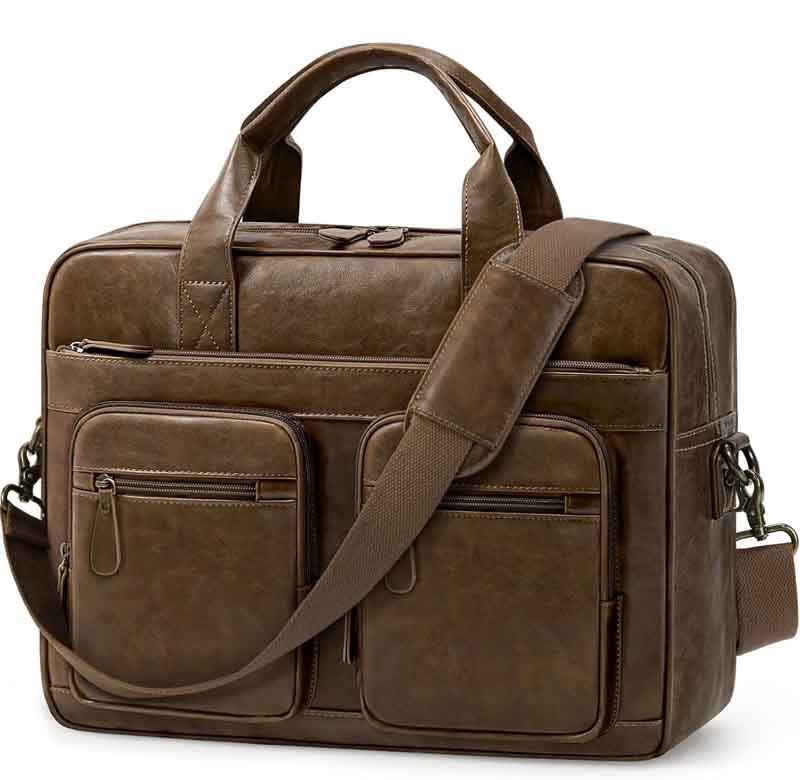
Szoneier is a trusted leather goods manufacturer with over 18 years of experience. We specialize in crafting high‑quality, customizable leather briefcases that meet the unique needs of businesses around the world. With low MOQs, fast prototyping, and competitive pricing, Szoneier is your go‑to partner for customized leather products.
Proven Leather R&D & Tanning Capabilities
- In-House Labs: Tensile, abrasion, and color-fastness testing under one roof ensures hide consistency.
- Custom Finishes: Our R&D team develops bespoke leather treatments—matte, aniline, pebble, waxed—that align precisely with your brand vision.
Low Minimums & Fast Sampling
- MOQ 50 pcs: Ideal for pilot runs or limited-edition corporate gifts without overcommitting budget.
- 5-Day Sample Turnaround: From your approved tech pack to a physical prototype in under a week keeps your product launch on schedule.
Lean, Cost-Efficient Manufacturing
- CNC and Die Cutting: Reduces material waste by up to 8%, lowering per-unit leather cost.
- Shared Dye Batches: Consolidate multiple colorways to cut setup fees by 15% without delaying production.
Rigorous Quality Control
- Inline & Final Audits: We maintain a defect rate under 1% through continuous QC checks.
- Digital QC Reports: Every order comes with batch photos and test data—complete transparency for your peace of mind.
Custom Branding & Packaging
- Logo Treatments: From blind deboss to multi-color foil stamping, plus custom hardware finishes (matte black, antique brass).
- Bespoke Packaging: Branded dust bags, recyclable cartons, and gift-ready presentation elevate your corporate gifting impact.
Global Logistics & Compliance
- DDP Shipping: Door-to-door delivery with duties paid, simplifying your import process.
- Certifications: ISO 9001, LWG for leather sourcing, and REACH compliance on all chemicals ensure regulatory peace of mind.
Sustainability & Ethical Practices
- LWG-Certified Hides: Traceable, eco-friendly sourcing minimizes environmental footprint.
- Fair-Wage Suppliers: Audited factories guarantee worker welfare and social compliance.
By partnering with Szoneier, you not only gain a factory, you gain a strategic ally that elevates your brand through quality, speed, and sustainable practices. Contact us today to discuss your next customizable briefcase order and let’s make your corporate vision a reality.



